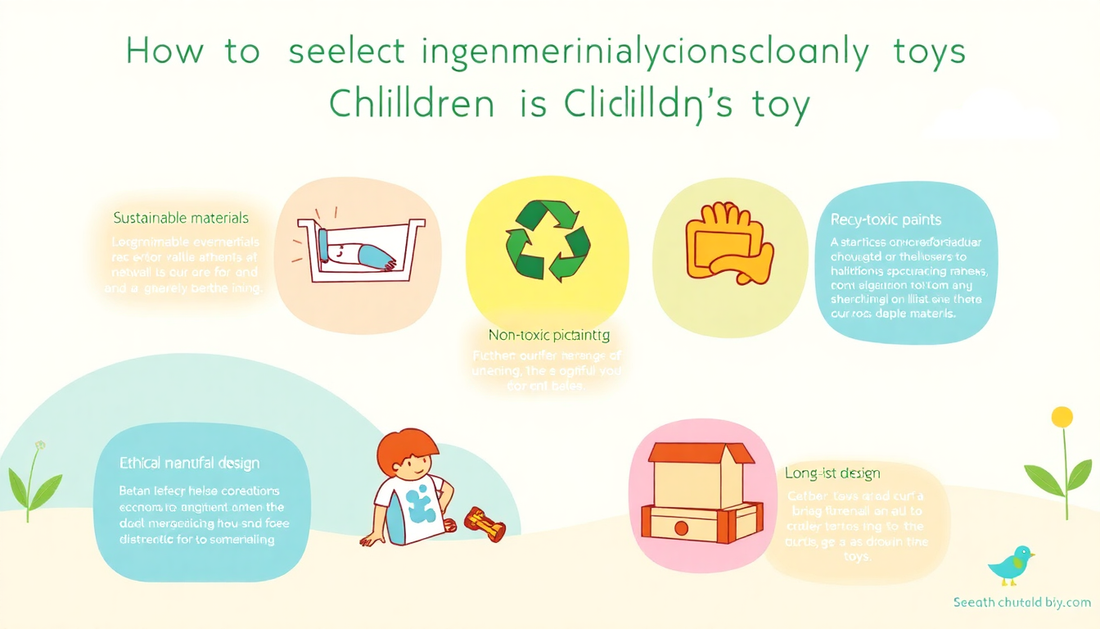
5 Things to Check When Choosing Eco-Friendly Toys for Your Kids
Share
As parents, we want to provide our children with the best possible toys that not only spark their imagination and creativity but also align with our values of sustainability and environmental consciousness. With the growing awareness of the impact our choices have on the planet, the demand for eco-friendly toys has never been higher. But with so many options available, it can be overwhelming to navigate the world of green toys and ensure we're making the right choices for our little ones.
In this blog post, we'll explore the key factors to consider when selecting eco-friendly toys for your kids, empowering you to make informed decisions that prioritize their well-being and the health of our planet.
Material Safety
The first and most crucial aspect to consider when choosing eco-friendly toys is the materials used in their construction. Avoid toys made with harmful chemicals, such as PVC, phthalates, and BPA, as these can have adverse effects on children's health. Instead, opt for toys made from natural, organic, and non-toxic materials like wood, cotton, silicone, and plant-based plastics.
Wooden toys, for instance, are a fantastic choice as they are durable, biodegradable, and often sourced from sustainably managed forests. Similarly, toys made from organic cotton or natural fibers like wool and hemp are gentle on delicate skin and can be safely chewed on by curious little ones.
When it comes to plastic toys, look for those made from bioplastics derived from renewable resources like corn, sugarcane, or plant-based materials. These alternatives are not only safer but also break down more easily, reducing their environmental impact.
Sustainability Factors
Sustainability is a key consideration when selecting eco-friendly toys. Look for toys that are manufactured using renewable, recyclable, or biodegradable materials, as well as those produced with energy-efficient and low-waste processes.
Investigate the toy company's commitment to sustainability, such as their use of renewable energy, their efforts to reduce carbon emissions, and their policies on waste management and recycling. Brands that are transparent about their environmental practices and hold themselves accountable are more likely to offer truly sustainable products.
Additionally, consider the toy's longevity and potential for multiple uses. Toys that can be passed down from one child to the next or repurposed for different play scenarios are more sustainable than those with a limited lifespan.
Durability and Longevity
Eco-friendly toys should not only be safe and sustainable but also durable and long-lasting. Look for toys that are well-made, with sturdy construction and high-quality materials that can withstand the rigors of play.
Toys that are designed to grow with your child or have multiple functions are particularly valuable, as they can be used for a more extended period and provide more play value. For example, a wooden building set that can be used for various construction projects or a plush toy that can transition from a cuddly companion to a pretend play prop.
By investing in durable, long-lasting toys, you not only reduce waste but also ensure your child can enjoy their favorite playthings for years to come.
Brand Transparency
When selecting eco-friendly toys, it's essential to research the brands and manufacturers to ensure they align with your values. Look for companies that are transparent about their production processes, materials used, and environmental impact.
Check for third-party certifications, such as GOTS (Global Organic Textile Standard), FSC (Forest Stewardship Council), or Cradle to Cradle, which verify the sustainability and safety of the toys. These certifications can give you peace of mind that the toys you're purchasing meet rigorous standards for environmental and social responsibility.
Additionally, explore the brand's mission and values to understand their commitment to sustainability. Look for companies that actively work to reduce their carbon footprint, use renewable energy, and support ethical labor practices.
Play Value and Educational Benefits
While eco-friendliness is a crucial factor, it's also essential to consider the play value and educational benefits of the toys you choose. Opt for toys that stimulate your child's imagination, encourage creativity, and promote learning through play.
Look for toys that are designed to be open-ended, allowing children to explore and experiment with different ways of using them. Wooden blocks, art supplies, and pretend play sets are excellent examples of toys that foster creativity and problem-solving skills.
Additionally, consider toys that have an educational component, such as those that teach about the natural world, encourage STEM (Science, Technology, Engineering, and Mathematics) learning, or help develop fine motor skills. These toys not only provide enjoyment but also contribute to your child's overall development.
By prioritizing both eco-friendliness and play value, you can ensure that the toys you choose are not only good for the environment but also engaging and beneficial for your child's growth and learning.
Conclusion
Choosing eco-friendly toys for your kids is a meaningful way to make a positive impact on the environment while providing them with safe, sustainable, and engaging playthings. By considering the factors of material safety, sustainability, durability, brand transparency, and play value, you can navigate the world of green toys with confidence and make choices that align with your family's values.
Remember, every eco-friendly toy you select is a step towards a more sustainable future for our children and the planet. So, take the time to research, explore, and discover the wonderful world of eco-friendly toys that will delight your little ones while also protecting the world they will inherit.
